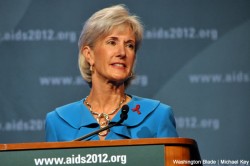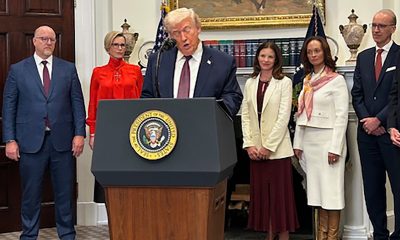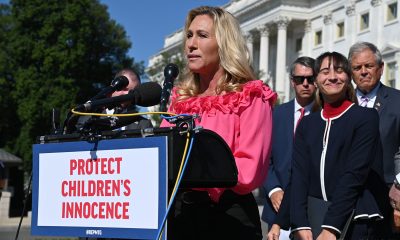National
LGBT-inclusive national suicide strategy unveiled
Discriminatory laws, ‘minority stress’ shown to contribute to LGBT suicide rate
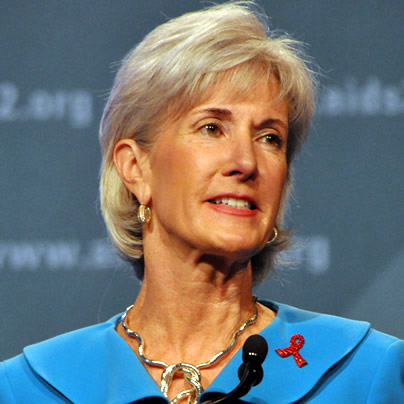
A new strategy unveiled Monday aimed at reducing the suicide rate in the United States includes a section on the rate of suicide for LGBT people — saying they may be particularly at risk because of “minority stress” and “institutional discrimination” resulting from anti-gay laws on the books.
The 2012 National Strategy for Suicide Prevention, made public on World Suicide Prevention Day, was published by the National Action Alliance for Suicide Prevention and U.S. Surgeon General Regina Benjamin. Secretary of Health & Human Services Kathleen Sebelius and former Defense Secretary of Robert Gates launched the alliance in late 2010 in part to address the suicide rate among Iraq and Afghanistan veterans returning home.
The strategy details multiple goals for reducing suicide, such as integrating suicide prevention into health care policies and changing the way the public talks about suicide and suicide prevention. In addition to veterans, the study identifies particular groups that may face a higher suicide rate, such as individuals with mental and substance abuse disorders, individuals in justice or child welfare settings and LGBT people.
Andrew Lane, a gay member of the Action Alliance’s executive committee, said the strategy lays the groundwork to reduce the suicide rate among LGBT people.
“The 2012 NSSP represents a significant step forward in our ongoing efforts to highlight the unique health needs of the LGBT community and ensure government responsiveness,” said Lane, who’s also executive director of the Johnson Family Foundation.
The strategy attributes the prevalence of suicide in the LGBT community to “minority stress” stemming from cultural stigma as well as “institutional discrimination” that comes from laws that deny benefits and protections for LGBT people that are provided to others.
“These negative outcomes, rather than minority sexual orientation or gender identity per se, appear to be the key risk factors for LGBT suicidal ideation and behavior,” the strategy states. “An additional risk factor is contagion resulting from media coverage of LGBT suicide deaths that presents suicidal behavior as a normal, rational response to anti-LGBT bullying or other experiences of discrimination.”
Among the factors that the strategy has found that reduce suicides among LGBT youth are family acceptance and access to mental health treatment. The Action Alliance also recommends reducing LGBT-related prejudices and associated stressors, improving access to LGBT-affirming treatment, working to reduce bullying and eliminating discriminatory laws. Notably, the strategy makes no mention of any particular discriminatory law against LGBT people that should be eliminated.
In a statement, Sebelius hailed the strategy as means to help organizations’ work in preventing suicides throughout the country.
“Our message today is one of hope,” Sebelius said. “The national strategy will bring together the nation’s resources, both public and private, in an organized effort to provide life saving services and improve the ability of individuals, friends and family members to recognize the warning signs of despair and take action to save lives.”
Sebelius announced HHS would provide $55.6 million in new grants for national, state, tribal, campus and community suicide prevention efforts, which were made possible under the Garrett Lee Smith Memorial Act and the Affordable Care Act. The Department of Veterans Affairs is launching a new outreach campaign called “Stand by Them: Help a Veteran.”
According to the strategy, whether LGBT people have a higher suicide rate than others is unknown because sexual orientation or gender identity isn’t recorded upon the death of an individual. However, the strategy does say studies indicate suicide ideation and attempts are higher for LGBT people.
“A meta-analysis of 25 international population-based studies found the lifetime prevalence of suicide attempts in gay and bisexual male adolescents and adults was four times that of comparable heterosexual males,” the strategy states. “Lifetime suicide attempt rates among lesbian and bisexual females were almost twice those of heterosexual females.”
The strategy makes particular note of the rate of suicide among LGBT youth. An analysis of studies found that LGB youth were three times more likely to report a lifetime attempt than straight youth, and more four times more likely to report a medically serious attempt.
A note of suicide among transgender people, saying population-based studies haven’t yet included transgender participants, but non-random surveys show the problem particularly affects transgender people. A 2009 study from the National Gay & Lesbian Task Force force found that 41 percent of adult respondents reported suicide attempts.
Michael Cole-Schwartz, a spokesperson for the Human Rights Campaign, praised the strategy.
“We applaud the National Strategy for Suicide Prevention and the efforts underway to improve the health and well-being of LGBT people – particularly youth that need to know there are people out there ready and willing to help them,” Cole-Schwartz said. “With public and private resources coming together this is a positive step toward lessening tragic deaths by suicide.”
It’s not the first time a national strategy has been issued to address the problem of suicide in the country, nor is it the first one to address the trend of suicide among LGBT youth. In the 2001, HHS under the direction of the Bush administration’s Surgeon General David Satcher unveiled a similar study about the national suicide rate that includes a paragraph addressing LGBT suicide. But this earlier strategy isn’t as detailed people for LGBT people, nor does it contain any explicit reference to suicide rates among transgender people.
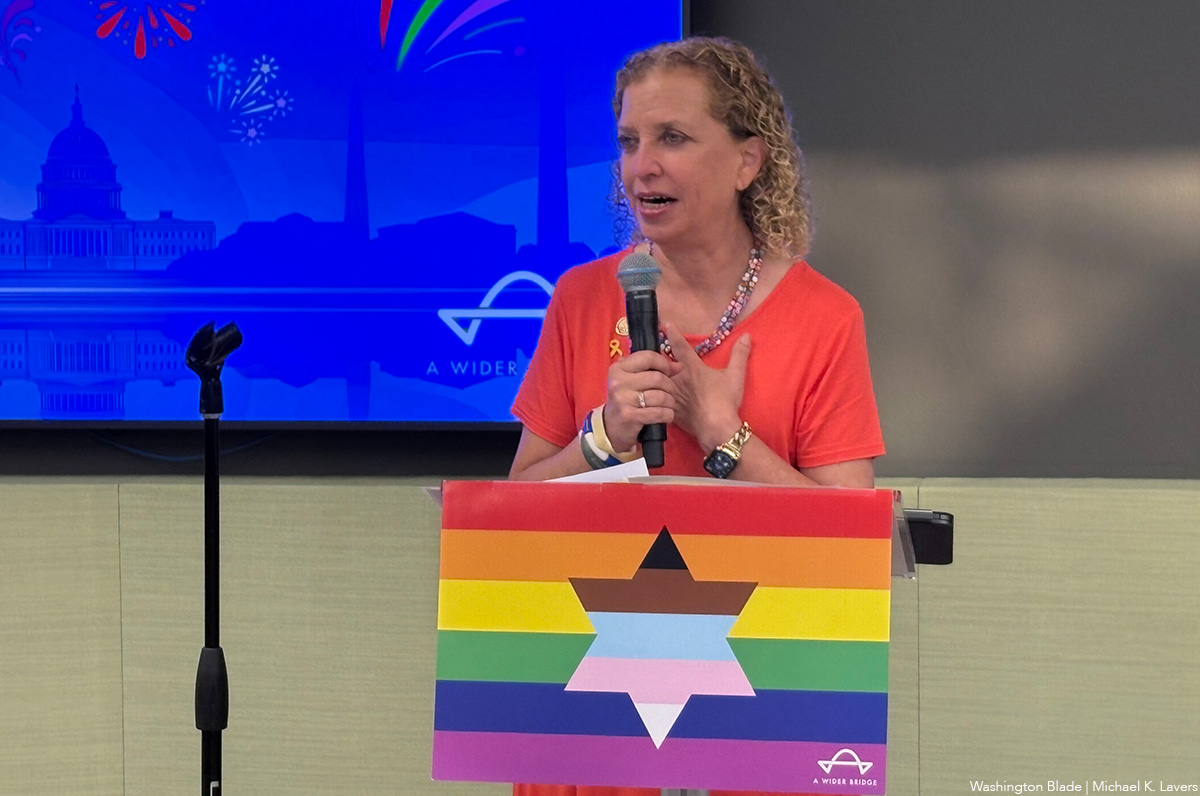
A Wider Bridge on Friday announced it will shut down at the end of the month.
The group that “mobilizes the LGBTQ community to fight antisemitism and support Israel and its LGBTQ community” in a letter to supporters said financial challenges prompted the decision.
“After 15 years of building bridges between LGBTQ communities in North America and Israel, A Wider Bridge has made the difficult decision to wind down operations as of Dec. 31, 2025,” it reads.
“This decision comes after challenging financial realities despite our best efforts to secure sustainable funding. We deeply appreciate our supporters and partners who made this work possible.”
Arthur Slepian founded A Wider Bridge in 2010.
The organization in 2016 organized a reception at the National LGBTQ Task Force’s Creating Change Conference in Chicago that was to have featured to Israeli activists. More than 200 people who protested against A Wider Bridge forced the event’s cancellation.
A Wider Bridge in 2024 urged the Capital Pride Alliance and other Pride organizers to ensure Jewish people can safely participate in their events in response to an increase in antisemitic attacks after Hamas militants attacked Israel on Oct. 7, 2023.
The Jewish Telegraphic Agency reported authorities in Vermont late last year charged Ethan Felson, who was A Wider Bridge’s then-executive director, with lewd and lascivious conduct after alleged sexual misconduct against a museum employee. Rabbi Denise Eger succeeded Felson as A Wider Bridge’s interim executive director.
A Wider Bridge in June honored U.S. Rep. Debbie Wasserman Schultz (D-Fla.) at its Pride event that took place at the Capital Jewish Museum in D.C. The event took place 15 days after a gunman killed two Israeli Embassy employees — Yaron Lischinsky and Sarah Milgrim — as they were leaving an event at the museum.
“Though we are winding down, this is not a time to back down. We recognize the deep importance of our mission and work amid attacks on Jewish people and LGBTQ people – and LGBTQ Jews at the intersection,” said A Wider Bridge in its letter. “Our board members remain committed to showing up in their individual capacities to represent queer Jews across diverse spaces — and we know our partners and supporters will continue to do the same.”
Editor’s note: Washington Blade International News Editor Michael K. Lavers traveled to Israel and Palestine with A Wider Bridge in 2016.
The White House
‘Trump Rx’ plan includes sharp cuts to HIV drug prices
President made announcement on Friday

President Donald Trump met with leaders from some of the world’s largest pharmaceutical companies at the White House on Friday to announce his new “Trump Rx” plan and outline efforts to reduce medication costs for Americans.
During the roughly 47-minute meeting in the Roosevelt Room, Trump detailed his administration’s efforts to cut prescription drug prices and make medications more affordable for U.S. patients.
“Starting next year, American drug prices will come down fast, furious, and will soon be among the lowest in the developed world,” Trump said during the meeting. “For decades, Americans have been forced to pay the highest prices in the world for prescription drugs by far … We will get the lowest price of anyone in the world.”
Trump signed an executive order in May directing his administration “to do everything in its power to slash prescription drug prices for Americans while getting other countries to pay more.”
“This represents the greatest victory for patient affordability in the history of American health care, by far, and every single American will benefit,” he added.
Several pharmaceutical executives stood behind the president during the announcement, including Sanofi CEO Paul Hudson, Novartis CEO Vas Narasimhan, Genentech CEO Ashley Magargee, Boehringer Ingelheim (USA) CEO Jean-Michel Boers, Gilead Sciences CEO Dan O’Day, Bristol Myers Squibb General Counsel Cari Gallman, GSK CEO Emma Walmsley, Merck CEO Robert Davis, and Amgen Executive Vice President Peter Griffith.
Also in attendance were Health and Human Services Secretary Robert F. Kennedy Jr., Commerce Secretary Howard Lutnick, Centers for Medicare and Medicaid Services Administrator Mehmet Oz, and Food and Drug Administration Commissioner Marty Makary.
Under the Trump Rx plan, the administration outlined a series of proposed drug price changes across multiple companies and therapeutic areas. Among them were reductions for Amgen’s cholesterol-lowering drug repatha from $573 to $239; Bristol Myers Squibb’s HIV medication reyataz from $1,449 to $217; Boehringer Ingelheim’s type 2 diabetes medication jentadueto from $525 to $55; Genentech’s flu medication xofluza from $168 to $50; and Gilead Sciences’ hepatitis C medication epclusa from $24,920 to $2,425.
Additional reductions included several GSK inhalers — such as the asthma inhaler advair diskus 500/50, from $265 to $89 — Merck’s diabetes medication januvia from $330 to $100, Novartis’ multiple sclerosis medication mayzent from $9,987 to $1,137, and Sanofi’s blood thinner plavix from $756 to $16. Sanofi insulin products would also be capped at $35 per month’s supply.
These prices, however, would only be available to patients who purchase medications directly through TrumpRx. According to the program’s website, TrumpRx “connects patients directly with the best prices, increasing transparency, and cutting out costly third-party markups.”
Kennedy spoke after Trump, thanking the president for efforts to lower pharmaceutical costs in the U.S., where evidence has shown that drug prices — including both brand-name and generic medications — are nearly 2.78 times higher than prices in comparable countries. According to the Pharmaceutical Research and Manufacturers of America, roughly half of every dollar spent on brand-name drugs goes to entities that play no role in their research, development, or manufacturing.
“This is affordability in action,” Kennedy said. “We are reversing that trend and making sure that Americans can afford to get the life-saving solutions.”
Gilead CEO Dan O’Day also spoke about how the restructuring of drug costs under TrumpRx, combined with emerging technologies, could help reduce HIV transmission — a virus that, if untreated, can progress to AIDS. The LGBTQ community remains disproportionately affected by HIV.
“Thank you, Mr. President — you and the administration,” O’Day said. “I think this objective of achieving the commitment to affordability and future innovation is extraordinary … We just recently launched a new medicine that’s only given twice a year to prevent HIV, and we’re working with Secretary Kennedy and his entire team, as well as the State Department, as a part of your strategy to support ending the epidemic during your term.
“I’ve never been more optimistic about the innovation that exists across these companies and the impact this could have on America’s health and economy,” he added.
Trump interjected, asking, “And that’s working well with HIV?”
“Yes,” O’Day replied.
“It’s a big event,” Trump said.
“It literally prevents HIV almost 100 percent given twice a year,” O’Day responded.
A similar anti-HIV medication is currently prescribed more than injectable form mentioned by O’Day. PrEP, is a medication regimen proven to significantly reduce HIV infection rates for people at high risk. Without insurance, brand-name Truvada can cost roughly $2,000 per month, while a generic version costs about $60 per month.
Even when medication prices are reduced, PrEP access carries additional costs, including clinic and laboratory fees, office visits, required HIV and sexually transmitted infection testing, adherence services and counseling, and outreach to potentially eligible patients and providers.
According to a 2022 study, the annual total cost per person for PrEP — including medication and required clinical and laboratory monitoring — is approximately $12,000 to $13,000 per year.
The TrumpRx federal platform website is now live at TrumpRx.gov, but the program is not slated to begin offering reduced drug prices until January.
The White House
EXCLUSIVE: Democracy Forward files FOIA lawsuit after HHS deadnames Rachel Levine
Trans former assistant health secretary’s name changed on official portrait
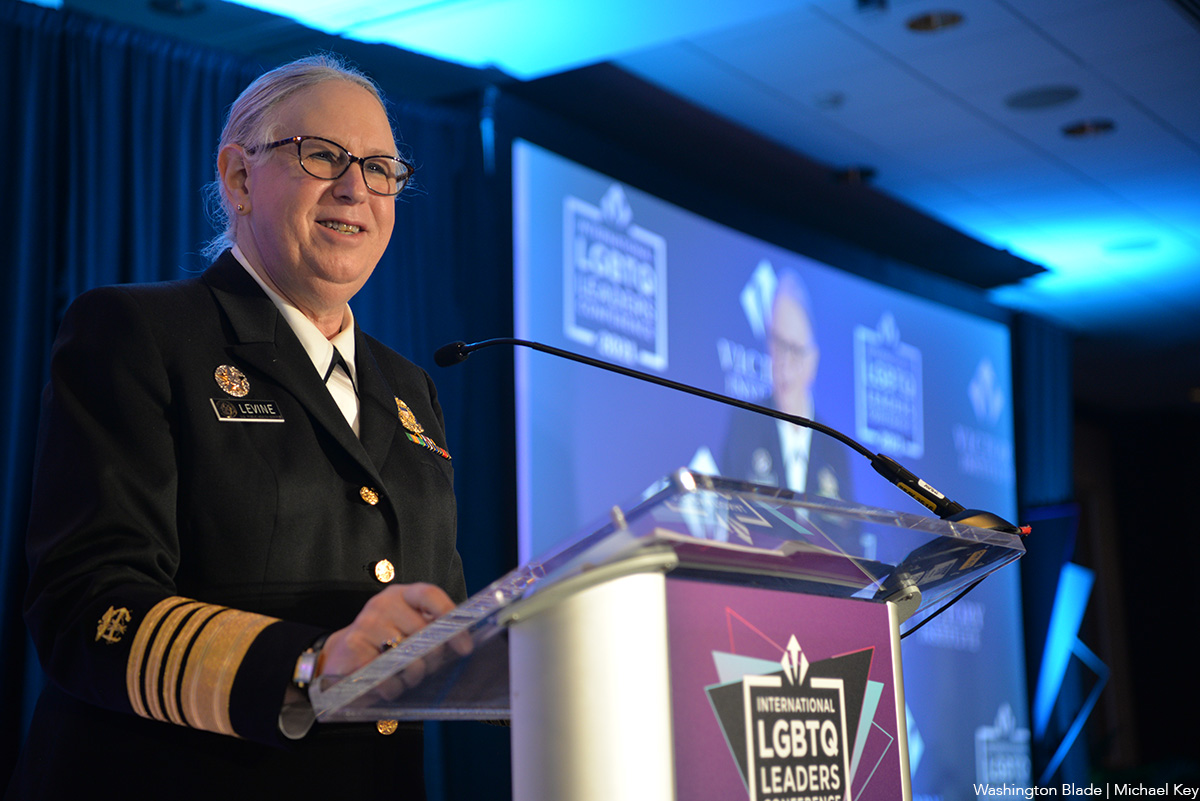
Democracy Forward, a national legal organization that works to advance democracy and social progress through litigation, policy and public education, and regulatory engagement, filed a lawsuit Friday in federal court seeking to compel the U.S. Department of Health and Human Services to release information related to the alteration of former Assistant Secretary for Health Adm. Rachel Levine’s official portrait caption.
The lawsuit comes in response to the slow pace of HHS’s handling of multiple Freedom of Information Act requests — requests that federal law requires agencies to respond to within 20 working days. While responses can take longer due to backlogs, high request volumes, or the need for extensive searches or consultations, Democracy Forward says HHS has failed to provide any substantive response.
Democracy Forward’s four unanswered FOIA requests, and the subsequent lawsuit against HHS, come days after someone in the Trump-Vance administration changed Levine’s official portrait in the Hubert H. Humphrey Building to display her deadname — the name she used before transitioning and has not used since 2011.
According to Democracy Forward, HHS “refused to release any records related to its morally wrong and offensive effort to alter former Assistant Secretary for Health Admiral Rachel Levine’s official portrait caption.” Levine was the highest-ranking openly transgender government official in U.S. history and served as assistant secretary for health and as an admiral in the U.S. Public Health Service Commissioned Corps from 2021 to 2025.
Democracy Forward President Skye Perryman spoke about the need to hold the Trump-Vance administration accountable for every official action, especially those that harm some of the most targeted Americans, including trans people.
“The question every American should be asking remains: what is the Trump-Vance administration hiding? For an administration that touts its anti-transgender animus and behavior so publicly, its stonewalling and silence when it comes to the people’s right to see public records about who was behind this decision is deafening,” Perryman said.
“The government’s obligation of transparency doesn’t disappear because the information sought relates to a trailblazing former federal official who is transgender. It’s not complicated — the public is entitled to know who is making decisions — especially decisions that seek to alter facts and reality, erase the identity of a person, and affect the nation’s commitment to civil rights and human dignity.”
“HHS’s refusal to respond to these lawful requests raises more serious concerns about transparency and accountability,” Perryman added. “The public has every right to demand answers — to know who is behind this hateful act — and we are going to court to get them.”
The lawsuit also raises questions about whether the alteration violated federal accuracy and privacy requirements governing Levine’s name, and whether the agency improperly classified the change as an “excepted activity” during a lapse in appropriations. By failing to make any determination or produce any records, Democracy Forward argues, HHS has violated its obligations under federal law.
The case, Democracy Forward Foundation v. U.S. Department of Health and Human Services, was filed in the U.S. District Court for the District of Columbia. The legal team includes Anisha Hindocha, Daniel McGrath, and Robin Thurston.
The Washington Blade reached out to HHS, but has not received any comment.
The lawsuit and four FOIA requests are below:
-

 Opinions5 days ago
Opinions5 days ago2026 elections will bring major changes to D.C. government
-

 Kazakhstan5 days ago
Kazakhstan5 days agoKazakh Senate approves anti-LGBTQ propaganda bill
-

 District of Columbia4 days ago
District of Columbia4 days agoNew queer bar Rush beset by troubles; liquor license suspended
-

 Letter-to-the-Editor5 days ago
Letter-to-the-Editor5 days agoCandidates should pledge to nominate LGBTQ judge to Supreme Court

